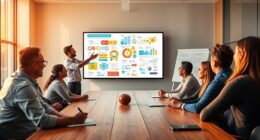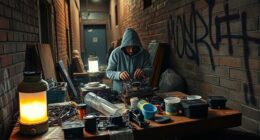Explore how companies like Nike, Airbnb, and GE Healthcare excel in design thinking by putting users first. Witness Nike's blend of comfort, performance, and style, Airbnb's user-focused innovation, and GE Healthcare's patient-centered solutions. Immerse yourself in Netflix's tailored recommendations and Google's user-centric projects. These real-world examples ignite your passion for creative solutions that prioritize users' needs and elevate experiences. Find inspiration in how industry leaders apply design thinking principles to revolutionize their fields and engage with audiences effectively. Get ready to be inspired by these innovative approaches that put users at the heart of the design process.
Key Takeaways
- Nike and Airbnb's success through user-centric innovation.
- GE Healthcare and Oral B's patient-focused designs.
- Netflix's personalized content delivery strategies.
- Google's Creative Lab and IDEO projects exemplify design thinking.
- Platform design strategies for user engagement by Netflix, IDEO, and Google.
Nike's User-Centric Design Approach
Nike's user-centric design approach places a strong emphasis on prioritizing user needs and preferences in the development of their athletic footwear. By focusing on comfort, performance, and style, Nike ensures that their shoes meet the demands of athletes and consumers alike.
Through prototyping and gathering user feedback, Nike iterates on designs to align with user preferences, resulting in innovative and successful athletic footwear. User feedback and testing are integral components of Nike's design process, allowing the brand to create products that resonate with their target audience.
This user-centric approach has been instrumental in Nike's ability to maintain its position as a leader in the athletic footwear industry, constantly pushing boundaries and setting trends. The company's commitment to understanding and meeting user needs has led to the creation of iconic footwear that not only performs well but also captures the essence of style and innovation.
Airbnb's Human-Centric Innovation Success

Airbnb's success in human-centric innovation has revolutionized the hospitality industry by applying design thinking principles to enhance the guest experience and address user pain points. This innovative approach not only increased Airbnb's market expansion but also set a new standard for user experience in the competitive marketplace.
By prioritizing human-centric design, Airbnb was able to meet consumer needs effectively, leading to its remarkable success. The company's focus on user experience and human-centric design principles has been key to its accomplishments. By understanding and catering to the needs of their guests, Airbnb differentiated itself in the market and saw substantial growth in revenue.
This commitment to creating a personalized and seamless guest experience through design thinking has solidified Airbnb's position as a leader in the hospitality industry. Overall, Airbnb's human-centric innovation success serves as a prime example of how design thinking can drive business excellence and customer satisfaction.
Netflix's Personalization Strategies

You'll discover how Netflix excels in delivering user-centric content, enhancing your viewing experience through personalized recommendations.
Their intentional platform design strategies are geared towards engaging you by tailoring content to your preferences.
These strategies showcase the power of design thinking in creating a more personalized streaming experience for you.
User-Centric Content Delivery
Netflix utilizes design thinking to enhance user experience by personalizing content delivery based on data-driven insights. This user-centric approach enables Netflix to offer customized recommendations tailored to individual preferences and viewing habits, ultimately creating a seamless interface for users to explore content effortlessly.
By continuously analyzing user behavior and feedback, Netflix guarantees that its content delivery remains engaging and relevant, leading to increased subscriber retention.
- Customized recommendations based on user preferences and viewing habits
- User-friendly interfaces for easy content discovery
- Continuous analysis of user feedback for improvement
- Engaging audiences through personalized content delivery
Netflix's dedication to design thinking principles in content delivery hasn't only transformed the way users interact with the platform but has also solidified its position as a leader in the digital streaming industry.
Enhancing User Experience
Enhancing user experience through personalized content delivery is a core strategy employed by Netflix to optimize satisfaction and engagement. By utilizing design thinking principles, Netflix tailors content recommendations based on data-driven insights to meet the preferences of its diverse customer base. Through this approach, Netflix not only secures user satisfaction but also increases user engagement with the platform.
For example, Netflix analyzes user behavior patterns to suggest personalized content that aligns with individual interests. This targeted content delivery strategy enhances the overall user experience by providing a seamless and enjoyable streaming experience. By understanding the importance of user-centric design thinking, Netflix has solidified its position as a leader in the streaming industry.
The success of Netflix's personalized content delivery model demonstrates the significance of employing design thinking to enhance user satisfaction and engagement in the competitive streaming landscape. Through continuous innovation and a focus on user experience, Netflix continues to set industry standards for personalized content delivery.
Platform Design Strategies
Utilizing design thinking principles, Netflix strategically tailors its platform design to personalize content delivery and enhance user engagement. Through a user-centric design approach, Netflix leverages data-driven insights to analyze behavior patterns and provide personalized recommendations.
The platform's design is meticulously crafted to optimize user engagement, ensuring a seamless and satisfying viewing experience. By continuously refining their interface based on design thinking principles, Netflix facilitates easy navigation and content discovery for users.
- Netflix uses design thinking to personalize content delivery based on user preferences and behavior patterns.
- Their platform design is intentionally crafted to enhance user engagement and satisfaction.
- Data-driven insights help Netflix create a seamless user experience through personalized recommendations.
- Design thinking principles guide Netflix in optimizing their interface for easy navigation and content discovery.
GE Healthcare's Patient-Centric Solutions

GE Healthcare implements design thinking to develop patient-centric medical solutions aimed at improving user experience and outcomes. Through this approach, GE Healthcare prioritizes collaboration with healthcare professionals to create innovative solutions in medical device design.
The company's process involves prototyping and testing to ensure that the final products meet user needs effectively. GE Healthcare's success in reducing children's anxiety during scans is a reflection of the power of its patient-centric design thinking.
By focusing on user feedback, GE Healthcare designs medical devices that aren't only efficient but also user-friendly. This commitment to user-centered design drives continuous improvement and innovation within the healthcare industry, ultimately enhancing patient care and outcomes.
GE Healthcare's dedication to putting patients at the center of its design process sets a standard for creating impactful and meaningful solutions in the medical field.
Oral B's User-Friendly Product Design

Oral B excels in creating user-friendly oral care products by leveraging design thinking principles to prioritize user needs and feedback. Through their dedication to user research and feedback, Oral B has developed innovative toothbrush designs that are both effective and easy to use.
Their product design process revolves around understanding user needs, resulting in toothbrushes that enhance the overall oral care experience.
- Oral B highlights user empathy and iterative improvement in their product design.
- The partnership with design thinking experts like IDEO has assisted Oral B in creating toothbrushes tailored to specific user preferences.
- User-centric approach of Oral B's design thinking guarantees products that meet consumer expectations.
- The emphasis on customer satisfaction propels Oral B to continuously innovate in their product design, keeping users at the forefront of their design process.
Innovative Design Thinking Projects

Collaborations between companies like IDEO and Google's Creative Lab have resulted in innovative design thinking projects that aim to address specific user needs and create impactful solutions. For instance, Oral B partnered with IDEO to improve toothbrush design for children by integrating user research and iterative development processes. This approach emphasizes user-centric design, iterative development, and the importance of tailoring solutions to meet users' requirements effectively.
Similarly, Project Bloks, a joint effort between Google's Creative Lab and IDEO, focused on using design thinking principles to make coding more accessible and tangible for children. These projects showcase how design thinking in action involves prototyping, testing, and collaboration to produce innovative solutions such as child-friendly toothbrushes and interactive coding tools.
Frequently Asked Questions
How Do We Use Design Thinking in Real Life?
When using design thinking in real life, focus on user needs, define problems, brainstorm solutions, create prototypes, and test them. This process leads to innovation, customer satisfaction, and a competitive edge for businesses.
What Is an Example of Design Thinking?
To understand design thinking, consider Airbnb's success in enhancing user experience. They attracted more renters by focusing on user needs. By simplifying medication management, PillPack was acquired by Amazon for $1 billion.
What Is a Real Life Example of Ideation?
When brainstorming ideas, think big like redesigning a city park to promote community engagement. Incorporate diverse perspectives for innovative solutions. Ideation fosters creativity and problem-solving. Embrace the process and let your imagination soar.
How Has Starbucks Used Design Thinking?
Starbucks used design thinking by focusing on creating inviting spaces for customers, promoting engagement. Its success is tied to a user-centric approach and attention to customer needs, enhancing brand loyalty and satisfaction.
Conclusion
As you explore these real-world design thinking examples, remember that just like a sculptor shaping a block of marble, you have the power to mold your ideas into something truly remarkable.
Embrace the creative process, think outside the box, and let your imagination soar. Let these stories serve as a beacon, guiding you towards innovative solutions and inspiring you to harness your full potential as a designer.
The world is your canvas – go forth and create masterpieces!









